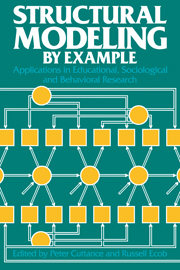Book contents
- Frontmatter
- Contents
- Preface
- List of contributors
- 1 Introduction
- 2 An overview of structural equation modeling
- 3 Field dependence and the differentiation of neurotic syndromes
- 4 High school seniors' reports of parental socioeconomic status: black–white differences
- 5 Modeling the hierarchical structure of learning
- 6 A study of longitudinal causal models comparing gain score analysis with structural equation approaches
- 7 Some structural equation models of sibling resemblance in educational attainment and occupational status
- 8 Applications of structural equation modeling to longitudinal educational data
- 9 The robustness of maximum likelihood estimation in structural equation models
- 10 An inquiry into the effects of outliers on estimates of a structural equation model of basic skills assessment
- 11 Testing structural equation models
- 12 LISREL models for inequality constraints in factor and regression analysis
- 13 Issues and problems in the application of structural equation models
- Appendix
- Glossary
- Index
2 - An overview of structural equation modeling
Published online by Cambridge University Press: 12 January 2010
- Frontmatter
- Contents
- Preface
- List of contributors
- 1 Introduction
- 2 An overview of structural equation modeling
- 3 Field dependence and the differentiation of neurotic syndromes
- 4 High school seniors' reports of parental socioeconomic status: black–white differences
- 5 Modeling the hierarchical structure of learning
- 6 A study of longitudinal causal models comparing gain score analysis with structural equation approaches
- 7 Some structural equation models of sibling resemblance in educational attainment and occupational status
- 8 Applications of structural equation modeling to longitudinal educational data
- 9 The robustness of maximum likelihood estimation in structural equation models
- 10 An inquiry into the effects of outliers on estimates of a structural equation model of basic skills assessment
- 11 Testing structural equation models
- 12 LISREL models for inequality constraints in factor and regression analysis
- 13 Issues and problems in the application of structural equation models
- Appendix
- Glossary
- Index
Summary
Introduction
As indicated in Chapter 1, structural equation modeling can be conveniently viewed as a product of the merging of two approaches to model fitting: multiple regression and factor analysis. The multiple regression approach expresses the relationship of a dependent variable to a number of regressor variables, the partial relationship with each variable being expressed by the regression coefficient corresponding to that variable. In contrast, the factor analysis approach finds a number of underlying or latent variables (or factors) that account for the common relationship among a number of observed variables.
In this chapter we examine characteristics of the two approaches and illustrate the differences between them. We then show how the method of structural equation modeling arises from a merging of the two approaches. Finally, we list and explain the general conditions, or framework assumptions, of the models examined and the statistical assumptions required to make the estimation of the models tractable.
The regression (or structural) model
The regression model has four basic characteristics. First, it comprises one equation. Second, this equation specifies a directional relationship between two sets of variables, the dependent variable and a set of regressor variables. The variation in the dependent variable is explained by a weighted combination of the values of the regressor variables, the weights being the regression coefficients. Third, the regressor variables are assumed to be measured without error. Fourth, each regressor variable is assumed to be linearly related to the dependent variable.
Of these four basic characteristics, only the second is fundamental to the regression model. All the others can be relaxed within the so-called general linear model.
- Type
- Chapter
- Information
- Structural Modeling by ExampleApplications in Educational, Sociological, and Behavioral Research, pp. 9 - 23Publisher: Cambridge University PressPrint publication year: 1988
- 1
- Cited by



